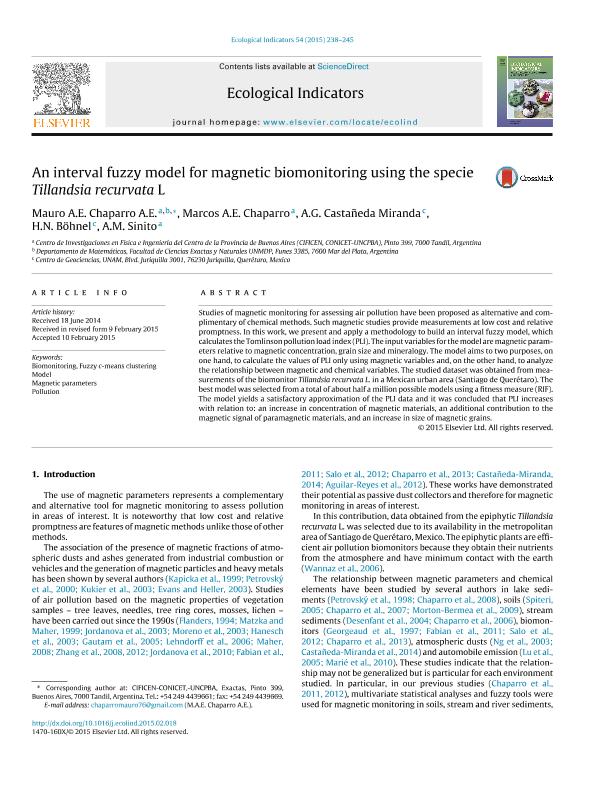Mostrar el registro sencillo del ítem
dc.contributor.author
Chaparro, Mauro Alejandro Eduardo

dc.contributor.author
Chaparro, Marcos Adrián Eduardo

dc.contributor.author
Castaneda Miranda, A. G.
dc.contributor.author
Böhnel, Harald N.
dc.contributor.author
Sinito, Ana Maria

dc.date.available
2016-03-03T15:14:04Z
dc.date.issued
2015-07
dc.identifier.citation
Chaparro, Mauro Alejandro Eduardo; Chaparro, Marcos Adrián Eduardo; Castaneda Miranda, A. G.; Böhnel, Harald N.; Sinito, Ana Maria; An interval fuzzy model for magnetic biomonitoring using the specie Tillandsia recurvata L.; Elsevier; Ecological Indicators; 54; 7-2015; 238-245
dc.identifier.issn
1470-160X
dc.identifier.uri
http://hdl.handle.net/11336/4594
dc.description.abstract
Studies of magnetic monitoring for assessing air pollution have been proposed as alternative and complimentary of chemical methods. Such magnetic studies provide measurements at low cost and relative promptness. In this work, we present and apply a methodology to build an interval fuzzy model, which calculates the Tomlinson pollution load index (PLI). The input variables for the model are magnetic parameters relative to magnetic concentration, grain size and mineralogy. The model aims to two purposes, on one hand, to calculate the values of PLI only using magnetic variables and, on the other hand, to analyze the relationship between magnetic and chemical variables. The studied dataset was obtained from measurements of the biomonitor Tillandsia recurvata L. in a Mexican urban area (Santiago de Querétaro). The best model was selected from a total of about half a million possible models using a fitness measure (RIF). The model yields a satisfactory approximation of the PLI data and it was concluded that PLI increases with relation to: an increase in concentration of magnetic materials, an additional contribution to the magnetic signal of paramagnetic materials, and an increase in size of magnetic grains.
dc.format
application/pdf
dc.language.iso
eng
dc.publisher
Elsevier

dc.rights
info:eu-repo/semantics/openAccess
dc.rights.uri
https://creativecommons.org/licenses/by-nc-nd/2.5/ar/
dc.subject
Biomonitoring
dc.subject
Fuzzy C-Means Clustering
dc.subject
Model
dc.subject
Magnetic Parameters
dc.subject
Pollution
dc.subject.classification
Ciencias Medioambientales

dc.subject.classification
Ciencias de la Tierra y relacionadas con el Medio Ambiente

dc.subject.classification
CIENCIAS NATURALES Y EXACTAS

dc.title
An interval fuzzy model for magnetic biomonitoring using the specie Tillandsia recurvata L.
dc.type
info:eu-repo/semantics/article
dc.type
info:ar-repo/semantics/artículo
dc.type
info:eu-repo/semantics/publishedVersion
dc.date.updated
2016-03-30 10:35:44.97925-03
dc.journal.volume
54
dc.journal.pagination
238-245
dc.journal.pais
Países Bajos

dc.journal.ciudad
Amsterdam
dc.description.fil
Fil: Chaparro, Mauro Alejandro Eduardo. Consejo Nacional de Investigaciones Científicas y Técnicas. Centro Científico Tecnológico Tandil. Centro de Investigaciones en Física e Ingeniería del Centro de la Provincia de Buenos Aires; Argentina. Universidad Nacional de Mar del Plata. Facultad de Ciencias Exactas y Naturales; Argentina
dc.description.fil
Fil: Chaparro, Marcos Adrián Eduardo. Consejo Nacional de Investigaciones Científicas y Técnicas. Centro Científico Tecnológico Tandil. Centro de Investigaciones en Física e Ingeniería del Centro de la Provincia de Buenos Aires; Argentina
dc.description.fil
Fil: Castaneda Miranda, A. G.. Universidad Nacional Autónoma de México. Centro de Geociencias; México
dc.description.fil
Fil: Böhnel, Harald N.. Universidad Nacional Autónoma de México. Centro de Geociencias; México
dc.description.fil
Fil: Sinito, Ana Maria. Consejo Nacional de Investigaciones Científicas y Técnicas. Centro Científico Tecnológico Tandil. Centro de Investigaciones en Física e Ingeniería del Centro de la Provincia de Buenos Aires; Argentina
dc.journal.title
Ecological Indicators

dc.relation.alternativeid
info:eu-repo/semantics/altIdentifier/doi/http://dx.doi.org/10.1016/j.ecolind.2015.02.018
dc.relation.alternativeid
info:eu-repo/semantics/altIdentifier/url/http://www.sciencedirect.com/science/article/pii/S1470160X15000953
dc.relation.alternativeid
info:eu-repo/semantics/altIdentifier/issn/1470-160X
Archivos asociados
